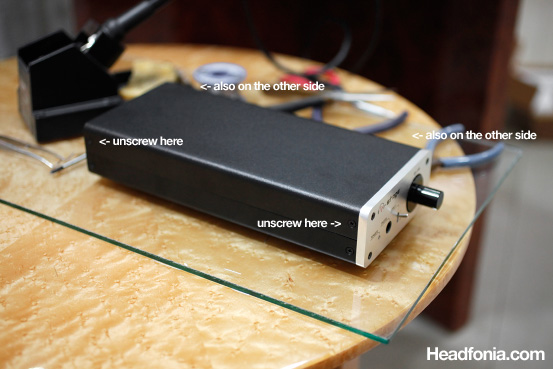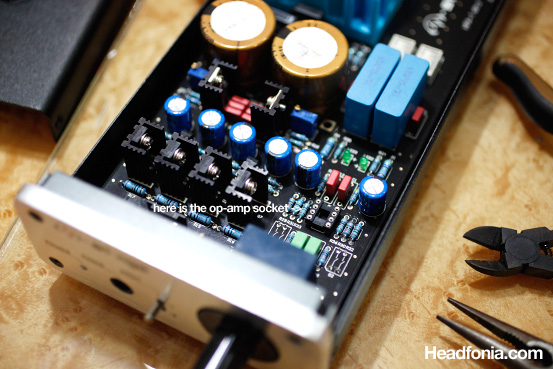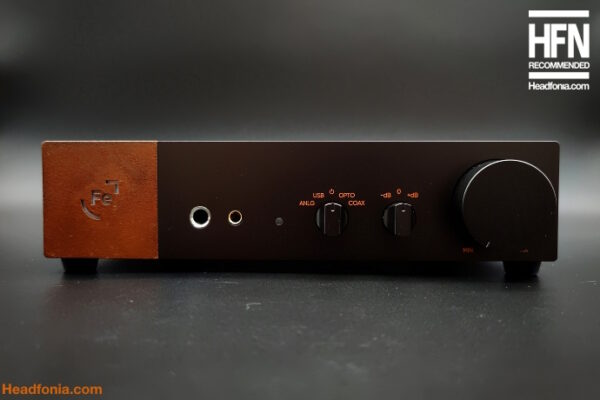I was totally happy with the Matrix M-Stage’s performance, and it has officially taken the spot of my new favorite entry level amp. Moreover, I’ve been listening to the M-Stage with the Hifiman HE5LE, and though the Hifiman EF5 is a superb pairing with the HE5LE, somehow the solid state man inside me keeps on pluggin the HE5LE with the M-Stage amp.
As I briefly mentioned in the M-Stage review, replacing the stock opamp with a top-grade opamp like the OPA627 took the M-Stage’s performance to another level. Then, purrin commented on the M-Stage review that I should bring the performance of the M-Stage even further by biasing the opamps into Class A. Removing the input coupling caps of the M-Stage would also clear up any coloration brought by the capacitors, but I didn’t do this part because I use the M-Stage with a variety of different sources.
Anyway, this is a pictorial guide for those of you wanting to try biasing the opamps into Class A on the M-Stage.
First you need to open the top panel by removing the four screws on the sides.










purrin
🙂
coolfungadget
great job, purrin & mike!
Professor00179
Nice job.:D
Mike
Thank you guys. 🙂
@purrin: what current bias setting do you use? 5mA is running a little warm to hot on my set up. 🙂
Iyayy
simple stupid question..
how do i know what resistor value to start with on different opa?
there should be something to refer to based on spec sheet right?
is higher resistance = less current when biasing?
thx.
Mike
I was told that 5mA should be quite a good figure to aim for, as lower amperes may not have too much of an effect. Of course it can be different for different opamps, but I really haven't experimented much.
Here is the basic formula:
15 V (opamp running voltage, measure from pin 4 or 8 ) / 0.005 A (or whatever desired figure you want) = 3000 Ohms (the resistor you need to use). I use 2.7KOhms as a close approximation to 3000 Ohms.
Iyayy
that would be very helpful..
will probably try it out later,
but im using LM4920NA, dont have 627.. i found it quite nice tho, except that the treble is slightly messy. hoping this biasing would fix the problem.
thanks.
Mike
Hmm… let me know how it works out.
wwenze
Note that the pinout of single-channel and dual-channel op-amps are different, for the OPA2134 you connected both channels' output to V- which is correct, for the OPA627 you connected V+ to V- then to one of the offset-trim pins.
wwenze
Unless yours is two OPA627s mounted onto a 2x single SOIC to dual DIP adapter, in which case it is correct. For single-channel op-amps (both DIP and single SOIC on DIP adapter it would be pin 6 to pin 4.
Mike
Yes, wwenze, that is on a a 2 single SOIC to dual DIP adapter.
purrin
Hey Mike,
I'm currently using 3.3k right now which ~4.5mA. I may eventually settle on 3.9k. The chip gets warm but not hot – but I my ambient temps are around 70F. These op-amps don't like to take more than 5mA. You can push to 7mA, but that's really pushing it. I think as low as 2mA should get most of the good effects. I haven't done my math on the circuit, but 2mA should be enough, although what I've found is that different values tend to change the sound balance depending up on the chip. The LM4562 gets warmer (sound balance wise). LOL, I tried 2.2k for 6.8mA on LM4562 and it was too way warm/bassy. The BB chips seem to act differently though – I think they get brighter with more current.
Mike
Wow, dude! Your findings are really in-depth! I really haven't experimented any further with the other op-amps, or changing the bias current. It's interesting to hear that the different current bias changes the balance of the sound.
purrin
Yes, I read somewhere else that pushing the LM4562 more into class A warmed up the sound. I didn't really believe it or give much thought to it when I made my DIP class A adapter when I only had a spare 2.2k resister lying around (I was using 4.7k earlier before). After I put it in, I realized after some time "crap, this is way too warm". When my order of resistors came in, I promptly put in the 3.3k and thought that was more like it. I'm going to eventually settle with 3.9K probably for LM4562.
For OPA2107, I think it gets more of that U shaped curve the more you push it, although some others have said the treble disappears when you go past 5mA to 7mA.
iyayy
since i only have a pair of 10k resistor.. i end up using em with my LME 49860NA (sry for the wrong info previously)..
apparently it does improve clarity by reducing treble smearing. i also got slight extra depth.. initial impression is very pleasing. though it does tilt the signature to warmth a bit.
oh btw, im using lovely cube linear headphone amp, not the m-stage.. and, im not sure whether im more used to warm siggy, but i found it neutral at stock, and also with the un-biased 49860.
Arup
3.3k is waaaayy too small. Been using a 1.5k with 12V supplies & its splendid (I actually mean it transforms the sound). Try it!
Mike
Interesting. Thanks for the input Arup. What amp are you using?
cider-moe
Can the M-Stage adequately drive the LCD-2 and sound good?
Anonymous
Power level wise, yes. Sound quality is decent though.
cider-moe
Can the M-Stage adequately drive the LCD-2 and sound good?
Ton luppenga
Dear Sir(s),
After reading the smart solution of biasing up to class A I read something about 15V (specified operating volt of the OPA627). Do you have changed thise power supply voltage to? I want to go from 12V regulator value up to 15V in relation to the OPA627.
with my best regards, ton (the Netherlands)
Anonymous
Ton,
I don’t think you need to alter the voltage to 15 Volts as the OPA627 takes in a range of supply voltage from ±4.5 to ±18V as specified in the datasheet:
http://www.ti.com/lit/ds/symlink/opa627.pdf
Alain
Hi I don’t understand what I see and read … You write about a OPA627, but the picture shows a OPA2134PA, is it the same ?
Anonymous
Hi Alain,
You’re right the main picture is an OPA2134 and it is not the same as the OPA627.
Alain
ok then, do I have to order a OPA627 ? and do I have to connect the resistors as the same place as on your OPA2134 picture ?… Sorry I’m a newbie, and english is not my mother tongue 🙂
Anonymous
Alain,
You can do the class-A biasing on either the OAP2134 or the OPA627. The OPA627 is a better quality opamp.
You can buy the OPA627 already biased here: http://tamaudio.com/store/index.php?route=product/product&product_id=82
Alain
Great !
Thanks a lot, I’ll try this as soon as I receive it. Much easier for me 🙂
Anonymous
Awesome.
thecansmancan
so if i were to buy the after market op amp. I can open the m stage up just pull the stock op amp out (like gently take a pair of pliers to it?) And the aftermarket one just plugs right in? no soldering or otherwise special skills needed?
Mike
No soldering, just plug in and out. Watch out for the opamp orientation. There is a dimple on the opamp and you have to pay attention to it for the orientation.
Traveller2225
Hey so I know thi sfrom a while ago but basically with the pre soldered opa627 biased in the link all I would have to do is remove the 2134pa and put in the opa627 down in it’s place? just plug and play?
Edit: I just read someone elses response sorry I did not see this prior. Do you know the difference from teh link you posted from the Burr Brown OPA627AP with Class A Biasing Mod ? it is 10$ more and was wondering if it is any good?
Alfani Gunawan
how about OPA637AP?? Tamaudio says its better, but several pepaople says its cause overheating??
Mike
I haven’t tried it with OPA637 to be honest.
George
Would an OPA2227 be a good replacement for stock OPA2134?
Mike
George,
I haven’t quite tried that. I don’t see why it wouldn’t work. I liked the Matrix with the OPA627 since I haven’t yet “discovered” the OPA2227. Ever since I found the 2227, I’ve liked it better than the 627.